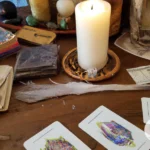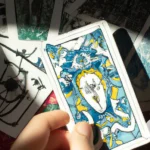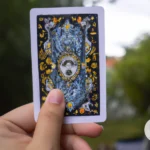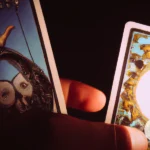Have you ever felt like there’s a part of yourself that you hide away from the world? An aspect of your personality that you try to ignore or suppress? This is known as your shadow self – a concept popularized by Swiss psychologist Carl Jung. While it may be uncomfortable to explore this side of yourself, embracing your shadow can lead to personal growth and self-awareness. Tarot, often associated with positive and uplifting messages, can also be a powerful tool for diving into the depths of your shadow self. In this article, we’ll explore the dark side of tarot and how it can help you confront your shadow self.
The Shadow Self
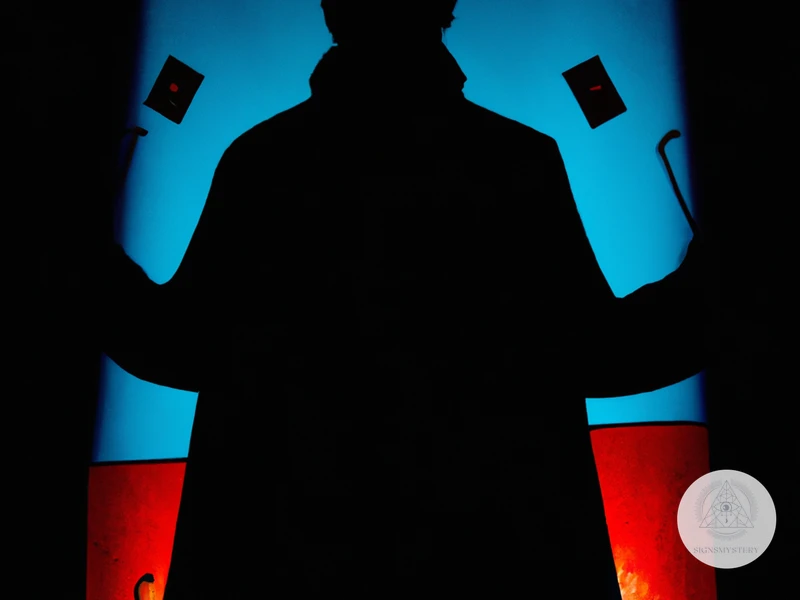
The Shadow Self refers to the unconscious parts of ourselves that we hide from the world, even from ourselves. These are parts that we feel ashamed of, fear, or judge negatively. However, rather than ignoring or repressing these aspects of ourselves, embracing the shadow self can lead to immense personal growth and healing. The shadow self can manifest in different ways, such as self-destructive behaviors, negative thought patterns, or intense emotional reactions. Through tarot reading and shadow work, individuals can explore and confront their shadow selves to gain greater self-awareness, self-acceptance, and self-love. In fact, tarot has proven to be an effective tool for illuminating the hidden parts of ourselves that we need to work on.
The Importance of Embracing Your Shadow
Embracing your shadow self can be a difficult and uncomfortable process, but it’s also incredibly important for personal growth and healing. The shadow self is the part of us that holds our repressed emotions, desires, and fears. These aspects of ourselves are often considered ‘negative’ and are pushed away because they don’t align with our desired self-image.
However, ignoring our shadow can lead to negative consequences such as low self-esteem, self-destructive behaviors, and even physical illness. By embracing our shadow, we become more integrated and accepting of all aspects of ourselves. This can lead to greater self-awareness, inner peace, and a more fulfilling life.
Tarot can be a powerful tool for exploring the shadow self. The archetypes and symbolism of the cards can help us uncover aspects of ourselves that we may not be fully aware of. Through tarot, we can safely confront our fears and negative emotions, allowing us to acknowledge and process them in a healthy way. This process of shadow work can be transformative, leading to greater self-understanding and acceptance.
It’s important to note that embracing our shadow shouldn’t be seen as a one-time event, but rather an ongoing process that requires self-exploration and reflection. By continually working with our shadow, we can develop a deeper understanding of ourselves and experience personal growth and healing.
If you’re interested in exploring shadow work through tarot, there are many resources available to guide you. Check out resources like Using Tarot Cards for Shadow Work Guide, Tarot Spreads for Shadow Work, and Tarot Journaling for Shadow Work. These tools can help you dive deeper into your shadow self and experience the transformative power of tarot.
How Tarot Can Help You Explore Your Shadow Self
Using tarot cards to explore your shadow self can be a powerful and transformative experience. The archetypal imagery and symbolism of the cards can help us tap into our unconscious mind and reveal aspects of ourselves that we may have been unaware of. Here are some ways in which tarot can help you explore your shadow self:
- Uncovering repressed feelings: When we suppress certain emotions or experiences, they can become buried in our shadow. Tarot can help bring these hidden feelings to the surface where we can acknowledge and process them. By asking questions related to a particular emotion or experience, we can use the cards to gain a deeper understanding of our feelings. For example, if you are feeling angry but you’re not sure why, you can use tarot to explore the root of that anger.
- Identifying negative patterns: We all have patterns of behavior that can hold us back or cause problems in our lives. Tarot can help us identify these patterns by revealing the underlying beliefs or fears that are driving them. For example, if you have a tendency to push people away when they get too close, tarot can help you understand why you feel the need to do that.
- Exploring fears and limiting beliefs: Our shadow self is often shaped by our fears and limiting beliefs. Tarot can help us confront these fears and beliefs by bringing them to the surface where we can examine them more closely. For example, if you have a fear of failure that is holding you back, tarot can help you explore where that fear comes from and how it is affecting your life.
- Empowering ourselves: Shadow work can be difficult and scary, but it can also be incredibly empowering. When we confront our shadow, we take back control over our lives and our choices. Tarot can help us see the strengths and resources that we have within us to face our fears and make positive changes in our lives.
By using tarot to explore our shadow self, we can gain a deeper understanding of who we are and what drives us. We can learn to embrace all aspects of ourselves, even those that we may have been taught to reject or hide away. The journey of self-discovery through tarot is a brave and liberating one that can lead to healing and transformation.
The Risks of Ignoring Your Shadow Self
Ignoring your Shadow Self can have serious consequences on your mental and emotional well-being. Here are some of the risks associated with ignoring your Shadow Self:
| Anxiety and Depression | Suppressing your Shadow Self can lead to feelings of anxiety and depression. Ignored parts of yourself can cause you to feel unfulfilled or constantly yearning for something more in life. |
| Self-Sabotage | When you don’t acknowledge your Shadow Self, you risk repeating negative patterns or self-sabotaging behavior. These behaviors can prevent you from reaching your goals and living the life you truly desire. |
| Unhealthy Relationships | Ignoring your Shadow Self can also impact your relationships. Unacknowledged fears, insecurities, or negative emotions can cause you to project them onto others, leading to codependency, toxic behavior, or other relationship issues. |
| Physical Symptoms | Suppressing your Shadow Self can also have physical effects on your body. Chronic stress, anxiety, and other negative emotions can lead to physical symptoms such as headaches, stomach problems, or chronic pain. |
By embracing your Shadow Self through tarot reading and other forms of shadow work, you can confront these risks and empower yourself to live a fuller, more authentic life. To learn more about the benefits of shadow work, read our article on Liberating Tarot Shadow Self.
The Dark Side of Tarot
Exploring the dark side of Tarot can be a daunting task, as it requires confronting our deepest fears and insecurities. However, this shadow work is crucial for understanding ourselves in a more profound and holistic way. As Carl Jung famously said, “One does not become enlightened by imagining figures of light, but by making the darkness conscious.” By delving into the darker aspects of ourselves through Tarot, we can gain a deeper understanding of our inner demons, and how they influence our thoughts and actions. While there are risks associated with this work, such as confronting difficult emotions like fear and shame, the benefits of embracing our shadow selves through Tarot are immeasurable. Through tools and spreads specifically designed for shadow work, as well as examples of how others have used Tarot to explore their own shadows, we can begin to see the potential for growth and transformation that lies within the darkest parts of ourselves.
Why We Fear the Dark Side
The fear of the unknown: The dark side of tarot represents the parts of ourselves that we may have repressed or denied. These aspects of ourselves may be uncomfortable, unknown, or uncharted territory. Fear of the unknown is a natural human response, but we must learn to overcome this fear in order to grow and develop as individuals.
The fear of judgment: Society often teaches us that certain emotions and behaviors are “bad” or “wrong”. As a result, we may become ashamed of these parts of ourselves and fear the judgment of others if we were to express them. However, denying or suppressing these parts of ourselves can lead to even more suffering.
The fear of losing control: Exploring the dark side of tarot may require us to confront emotions or experiences that we previously felt we couldn’t handle. This fear may stem from a lack of trust in ourselves to navigate challenging emotions and situations. However, by embracing our shadow side, we can learn to develop a healthy relationship with these feelings and take control of our lives.
The fear of facing our inner demons: We all have aspects of ourselves that we may not be proud of, but it’s important to confront them in order to grow and heal. The shadow side of tarot can help us to do just that – face our inner demons and work through the underlying issues that may be holding us back in life. By doing so, we can gain a greater sense of self-awareness and make positive changes in our lives.
The fear of vulnerability: Exploring the dark side of tarot requires us to be vulnerable and open to the parts of ourselves that we may have previously hidden away. This can be difficult, as vulnerability may be perceived as weakness. However, vulnerability is a strength that allows us to connect to ourselves and others on a deeper level.
There are many reasons why we may fear the dark side of tarot – from fear of the unknown to fear of vulnerability. However, by embracing these aspects of ourselves and working through any discomfort or fear that arises, we can gain a greater sense of self-awareness and move towards a more fulfilling life. To learn more about overcoming fear and shame in tarot shadow work, consider reading this article.
The Benefits of Exploring the Dark Side of Tarot
- Self-awareness: When we explore our dark side through tarot, we gain a greater understanding of ourselves. We become more aware of our own limitations, vulnerabilities, and tendencies toward negative behavior. This self-reflection can lead to personal growth and a deeper connection with our true selves.
- Healing: Shadow work can be a powerful tool for healing emotional wounds. By acknowledging and working through our fears, traumas, and negative experiences, we can release them and move forward with a greater sense of peace and wholeness.
- Empowerment: When we confront and overcome our dark side, we gain a sense of empowerment. We no longer feel controlled by our fears or negative emotions, but instead, we feel in control of our own lives.
- Deeper meaning: Exploring the darker aspects of tarot can help us gain a deeper understanding of the world around us. It can reveal profound truths about human nature, the nature of good and evil, and the complexities of the human experience.
Exploring the dark side of tarot can be a transformative and empowering experience that can lead to greater self-awareness, healing, and personal growth.
In order to really embrace the benefits
Subscribe to Our Newsletter
Sign up to receive the latest news and updates.
Tools and Spreads for Shadow Work
When it comes to doing shadow work with tarot, there are many tools and spreads that can help facilitate the process. Here are some options to consider:
| Tool/Spread | Description |
|---|---|
| The Shadow Self Spread | A popular spread for exploring the shadow self consists of 4 or 5 cards. The first card represents the light side, the second represents the shadow side, the third represents the root cause of the shadow, the fourth represents what needs to be integrated and the fifth (optional) represents the outcome of integrating the shadow self. |
| The Dark Mirror Oracle | This oracle deck is specifically designed for shadow work and includes 78 cards with striking imagery. Each card corresponds to a different facet of the shadow self and can help to illuminate the dark aspects that need to be integrated. |
| Journaling | While not technically a tool or spread, journaling is a powerful practice to use in conjunction with tarot for shadow work. After doing a tarot reading, take time to write down your reflections and insights about the cards. Use stream of consciousness writing to allow yourself to express your thoughts and feelings freely. This can help you to uncover buried emotions and beliefs. |
| The Tower Card | The Tower is one of the most feared cards in the tarot deck, but it can also be a powerful tool for shadow work. When this card appears in a reading, it can indicate a necessary breakdown of old structures that are no longer serving you. Use this as an opportunity to explore any fears or resistance to change that may be holding you back. |
| The Collective Shadow Spread | This spread is designed to explore the collective shadow, rather than just your personal shadow. It consists of 6 cards and can help to shed light on societal issues that need to be addressed. The first card represents the root of the issue, the second represents the manifestations of the shadow, the third represents what needs to be released, the fourth represents what needs to be embraced, the fifth represents the potential for change and the sixth represents the outcome of integrating the collective shadow. |
Remember, when it comes to shadow work with tarot, it’s important to trust your intuition and use the tools and spreads that resonate with you personally. Don’t be afraid to get creative and design your own spreads or modify existing ones to better suit your needs. As with any spiritual practice, the most important thing is to approach the work with an open mind and a willingness to explore the darker aspects of yourself.
Examples of Shadow Work in Tarot Reading
When it comes to shadow work in tarot reading, there are many examples that can be used to explore the darker aspects of oneself. One common example is the “What am I hiding from?” spread, which consists of three cards – the first representing what you are hiding from, the second representing the impact of that hiding, and the third representing how to face and overcome what you are hiding from.
Another useful spread for shadow work is the “Darkness and Light” spread, which consists of two parallel lines of four cards each. The first line represents the darkness that is present in your life, while the second line represents the light that can be found in the same situations. This spread helps to illuminate the positive aspects that can come from embracing the shadow self.
The “Dark Night of the Soul” spread is another example of a spread used for shadow work. This spread consists of three cards, representing the past, present, and future of a difficult situation or experience. It can help the reader to identify the source of their pain or struggle, and provide insight into how to move forward.
It’s worth noting that shadow work in tarot reading is not limited to spreads or specific cards, but can also be incorporated into any reading by paying attention to the darker aspects and potential sources of discomfort or fear. The key is to approach these aspects with compassion and curiosity, rather than judgment or avoidance.
Tarot can be a powerful tool for exploring the shadow self and uncovering areas of potential growth and healing. Through the use of specific spreads and a willingness to confront the darker aspects of oneself, tarot readers can gain valuable insights and clarity on their life path.
Conclusion
As we come to the end of this article on the dark side of Tarot and embracing your shadow self, it’s clear that there is much to be gained by delving into the depths of our psyche. Tarot can provide a powerful tool for exploring our shadow selves, and by doing so, we can gain greater self-awareness, inner strength, and emotional wholeness.
It’s important to remember, however, that this journey is not without its risks. We may uncover truths about ourselves that are uncomfortable or even painful to confront. We may face resistance from those around us who are resistant to exploring their own shadow self. But ultimately, the rewards of embracing our shadow selves and working with these dark aspects of Tarot far outweigh the risks.
If you’re new to the concept of shadow work, it may be helpful to start with a Tarot spread specifically designed for this purpose. The examples we provided in this article are just a starting point. Experimentation with different techniques and tools is the key to unlocking the full potential of your shadow work.
Remember that the tarot is a tool, and like any tool, it has both light and dark aspects. It’s up to each individual reader to determine how they want to wield that power. By embracing the dark side of Tarot, we open ourselves up to a deeper understanding of ourselves and the world around us. So go forth, embrace your shadow self, and use the Tarot to illuminate your path towards healing, growth, and inner transformation.
Frequently Asked Questions
1. Can tarot readings predict the future?
No, tarot readings do not predict the future. They offer insight into current situations and potential outcomes based on the choices you make.
2. Is tarot reading against any religion?
No, tarot reading is not against any religion. It is a tool for self-reflection and personal growth that can be integrated into any belief system.
3. Is it necessary to have a specific question in mind before a tarot reading?
No, it is not necessary to have a specific question in mind before a tarot reading. Tarot readings can offer guidance and insight into various aspects of your life.
4. Can anyone read tarot cards?
Technically, anyone can read tarot cards. However, it takes practice, intuition, and a deep understanding of symbolism to give accurate and insightful readings.
5. Is it indicative of a bad omen if a tarot reading has negative cards?
No, negative cards in a tarot reading do not necessarily indicate a bad omen. They offer insight into areas that may need attention and suggest potential obstacles.
6. How often should someone get a tarot reading?
There is no set guideline for how often someone should get a tarot reading. It is up to personal preference and the level of guidance and insight needed at any given time.
7. Is tarot reading a form of therapy?
No, tarot reading is not a form of therapy. It is a tool for self-reflection and personal growth that can be used in conjunction with therapy.
8. Can a tarot reading change the outcome of a situation?
No, a tarot reading cannot change the outcome of a situation. It offers insight and guidance, but ultimately, the choices made by the individual will determine the outcome.
9. Is it possible to have a tarot reading done for someone else?
Yes, it is possible to have a tarot reading done for someone else. However, it is important to have their consent and respect their privacy and boundaries.
10. Is it necessary to be in the same room as the tarot reader for a reading?
No, it is not necessary to be in the same room as the tarot reader for a reading. Tarot readings can be done remotely over the phone or through video chat.






